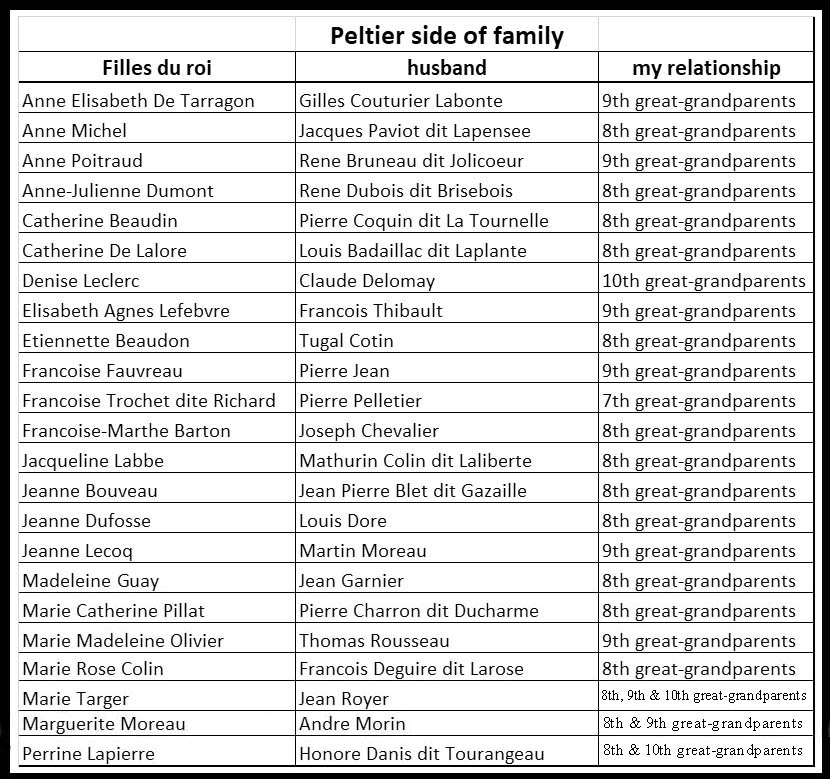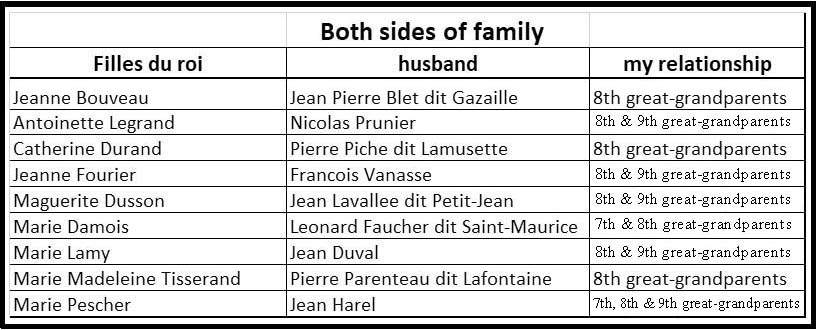Several years ago while researching a branch of the Vadnais family, I came across a record that showed this relative was a so called “filles du roi”. It was the first time I had seen the phrase so I googled it. The filles du roi, King’s daughters, are considered the mothers of the French Canadian descendants. Under the sponsorship of King Louis XIV of France, over 700 King’s daughters (the numbers vary according to the source) came to New France (Canada) between 1663 and 1673. The vast majority of these women married, resulting in a population explosion which gave rise to the success of the colony. Today most of the millions of people of French Canadian descent, in Quebec, the rest of Canada and in the United States are descendants of one or more of these hardy women of the 17th century. It was an honor to find that we had one of these brave women as an ancestor.
As my weeks of research progressed it was with pride I held onto this wonderful discovery. I continued to add people to the branches of the family tree and to my amazement 60 of the direct descendants I had added were King’s daughters. Below I list the King’s daughters that I have found thus far. They are divided into three tables that show those related to the Peltier side of the family, to the Vadnais side of the family and to both sides of the family. I’ve also included my relationship.



Some facts to give you a perspective on the colonization of New France
Some 14,000 French men and women immigrated to New France during the seventeenth century. (On the other hand, approximately 380,000 individuals from the British Isles immigrated to the New World between 1630 and 1699.) (Charbonneau 33, 34, 214)1
Approximately two-thirds of the French immigrants returned to the Old World or died unmarried in Canada. Only 3,400 French settled along the St. Lawrence River and laid the foundation for the new colony. [Just 3,400! I marvel at our French-Canadian genealogy springing from such a small population a mere 400 or so years ago.] (Charbonneau 40-41)1
This was an immigration dominated by males. In the censuses of 1666 and 1667, men outnumbered women two to one. [The reported male to female ratio in the young French colony varies considerably among historians. In his book, King’s Daughters and Founding Mothers: The Filles du Roi, 1663-1673, Peter Gagne reports that ”Up until the early 1670’s, there were six to 14 times as many men of marriageable age as there were women.” All researchers agree that there was a significant gender imbalance and that this impeded the growth of the colony.] (Charbonneau 27, 36)1
The great majority of the French were single when they emigrated: 87% of the men and 79% of the women. (Charbonneau 37)1
Most of the immigration took place in the ten years between 1663 and 1672, after the King (Louis XIV) assumed responsibility for colonization. One-third of the men and one-half of the women who came to the colony in the seventeenth century arrived during this ten-year period. This included the 770 King’s Daughters (Filles du roi). (Charbonneau 36-37)1
Of the women who came, very few returned to France. Almost all crossed the Atlantic with the specific intention of settling in the New World. Some came as wives or as children in immigrating families. Others, the King’s Daughters and the Filles a marier before them, came as young, marriageable women. They were not specifically forced to stay in Canada; however, once they had married and given birth to children, their situation left them with few options. (Charbonneau 199)1
Three-fourths of all emigrants from France had arrived in the colony by 1680. After that year, the population in the colony grew naturally, rather than through emigration from the Old World. (Charbonneau 37)1
Only two hundred more women immigrated to the colony after the arrival of the last contingent of King’s Daughters in 1673. (Charbonneau 37)1
There were three censuses in the seventeenth century, taken in 1666, 1667, and 1681 (the main period of immigration). Most of the country’s founders appear in these documents. Exceptions listed in the censuses are those who died or who returned to France prior to 1666. (Charbonneau 45)1
By 1680, both banks of the St. Lawrence River were settled. The census of 1681 lists a population of close to 10,000 in the colony. (Charbonneau 37)1
I will have much more to say about these early ancestors at a later time. Theirs’ is a rich history with many a story.
Thanks for visiting, come back soon,
Cynthia
© 2022 Copyright by Cynthia Vadnais, All Rights Reserved

Love it!! Every time I read one of your posts I marvel at all you have discovered & am so grateful you are sharing all this information with all of us. My dad would have so enjoyed your blog. Thanks for your time & dedication . Xoxo,Mary
Most interesting!!! Thanks so much. oxoxo